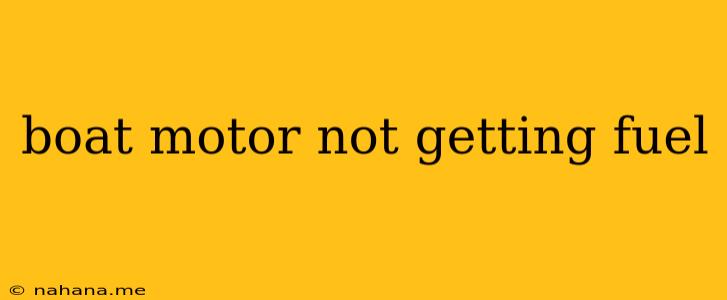A boat motor that's not getting fuel can be a frustrating problem, leaving you stranded on the water. But don't panic! With a little troubleshooting, you can often get your engine running again.
Common Causes of Fuel Problems
Here are the most common reasons why your boat motor might not be getting fuel:
- Empty Fuel Tank: This is the most obvious, but sometimes we forget to check!
- Fuel Line Blockage: Debris, dirt, or even algae can clog fuel lines, preventing fuel from reaching the engine.
- Fuel Filter Clogging: Fuel filters are designed to trap impurities, but they can become clogged over time.
- Fuel Pump Malfunction: The fuel pump is responsible for pushing fuel from the tank to the engine. A faulty pump won't deliver fuel.
- Fuel Valve Problem: The fuel valve controls the flow of fuel to the engine. If it's stuck closed, no fuel will get through.
- Carburetor Issues: A dirty or malfunctioning carburetor can prevent fuel from being properly mixed with air, leading to starting problems.
Troubleshooting Steps
Here's a step-by-step guide to troubleshooting fuel problems:
1. Check the Fuel Tank
- Is the tank empty? This might sound silly, but it's the easiest check!
- Is the fuel fresh? Old gas can gum up your engine.
- Is the fuel vent open? A blocked vent can create a vacuum in the tank, preventing fuel flow.
2. Inspect the Fuel Lines
- Visual inspection: Look for any kinks, cracks, or leaks in the fuel lines.
- Fuel line pressure test: If you have a fuel pressure gauge, test the pressure at the fuel pump outlet.
3. Examine the Fuel Filter
- Is it clean? Replace the fuel filter if it's dirty or clogged.
- Is it the right filter? Ensure you're using the correct type and size of fuel filter.
4. Test the Fuel Pump
- Listen for the pump: With the ignition on, you should hear the fuel pump running briefly.
- Check for fuel delivery: Disconnect the fuel line at the carburetor and see if fuel flows freely when the pump is running.
5. Check the Fuel Valve
- Is the valve open? Make sure the valve is in the "on" position.
- Is the valve working properly? Try opening and closing the valve to see if it moves freely.
6. Investigate the Carburetor
- Is it clean? A dirty carburetor can cause fuel delivery problems.
- Is it properly adjusted? A carburetor that's out of adjustment might not be mixing fuel and air correctly.
Getting Help
If you're unable to solve the problem yourself, it's best to seek professional help. A qualified marine mechanic can diagnose and repair fuel system issues quickly and efficiently.
Prevention Tips
- Use a fuel stabilizer: This helps prevent fuel from going bad, reducing the risk of clogging.
- Regularly inspect fuel lines and filters: Replace them as needed to avoid blockages.
- Keep your carburetor clean: Regular cleaning can prevent performance issues.
By following these troubleshooting steps and prevention tips, you can hopefully get your boat motor running smoothly again and enjoy your time on the water.
